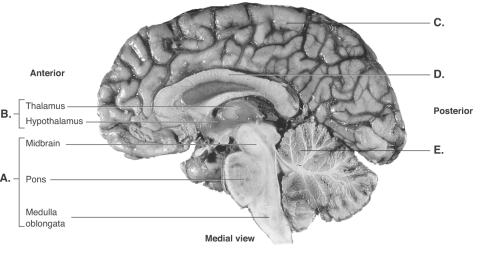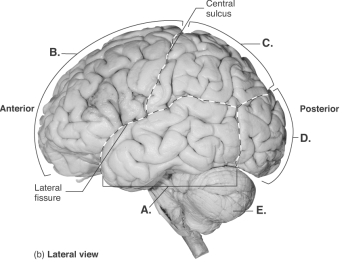A) cerebrum
B) cerebellum
C) corpus callosum
D) diencephalon
E) brainstem
G) None of the above
Correct Answer

verified
Correct Answer
verified
Multiple Choice
The superior colliculi receive input from the
A) eyes, skin, cerebrum and inferior colliculi.
B) inferior colliculi, pyramids, skin and red nucleus.
C) skin, ears, pyramids and cerebellum.
D) cerebrum, cerebellum, thalamus and inferior colliculi.
E) nose, tongue and inner ear.
G) C) and E)
Correct Answer

verified
Correct Answer
verified
Multiple Choice
Damage to branches of the _____ nerve can interfere with normal speech.
A) facial
B) vagus
C) trigeminal
D) glossopharyngeal
E) abducens
G) B) and C)
Correct Answer

verified
Correct Answer
verified
Multiple Choice
From which embryonic brain region does the cerebellum form?
A) telencephalon
B) diencephalon
C) mesencephalon
D) metencephalon
E) myelencephalon
G) B) and E)
Correct Answer

verified
Correct Answer
verified
Multiple Choice
Which of the following activities would stimulate the reticular formation?
A) a warm bath
B) a clock radio coming on in the morning
C) a long lecture in a darkened auditorium
D) eating a big meal
E) getting a back rub
G) C) and D)
Correct Answer

verified
Correct Answer
verified
Multiple Choice
The most superficial meningeal layer is
A) the pia mater.
B) the arachnoid layer.
C) the dura mater.
D) the epidural sinus.
E) the skull.
G) C) and E)
Correct Answer

verified
Correct Answer
verified
Multiple Choice
The basal nuclei function to
A) produce stiff, exaggerated movements.
B) assist the autonomic nervous system.
C) inhibit unwanted muscular activity.
D) control alertness.
E) store memory.
G) A) and B)
Correct Answer

verified
Correct Answer
verified
Multiple Choice
The limbic system involves various neural connections between
A) the medulla and pons.
B) the pons and cerebellum.
C) the cerebrum and diencephalon.
D) the diencephalon and midbrain.
E) the cerebrum and midbrain.
G) A) and E)
Correct Answer

verified
Correct Answer
verified
Multiple Choice
The accessory nerve
A) has fibers that join the vagus nerve.
B) has both a cranial and a spinal component.
C) provides innervation to the trapezius and sternocleidomastoid muscles.
D) is cranial nerve XI.
E) All of these choices are correct.
G) None of the above
Correct Answer

verified
Correct Answer
verified
Multiple Choice
The mammillary bodies
A) influence breast milk production.
B) produce reproductive hormones.
C) are involved in emotional responses to odors.
D) are found in the thalamus.
E) influence the onset of puberty.
G) A) and B)
Correct Answer

verified
Correct Answer
verified
Multiple Choice
The nuclei of cranial nerves III, IV, and V are located in the
A) pons.
B) medulla.
C) midbrain.
D) diencephalon.
E) cerebellum.
G) A) and C)
Correct Answer

verified
Correct Answer
verified
Multiple Choice
What structures are formed from neural crest cells?
A) sensory, autonomic, and enteric neurons
B) pigmented body cells
C) adrenal medulla
D) facial bones
E) All of the choices form from neural crest cells
G) A) and B)
Correct Answer

verified
Correct Answer
verified
Multiple Choice
Facial expression is regulated by the
A) facial nerve.
B) vagus nerve.
C) abducens nerve.
D) trigeminal nerve.
E) accessory nerve.
G) All of the above
Correct Answer

verified
Correct Answer
verified
Multiple Choice
When you walk up behind someone and tap their right shoulder, they will reflexively
A) raise their arms.
B) hit you.
C) turn their head toward the left.
D) sneeze.
E) turn their head toward the right.
G) B) and C)
Correct Answer

verified
Correct Answer
verified
Multiple Choice
Which of the following pairs is mismatched?
A) falx cerebri - longitudinal fissure
B) tentorium cerebelli - base of brain
C) falx cerebelli - between the cerebellar hemispheres
D) pia mater - surface of the brain
E) dural venous sinus - collects blood that returns from the brain
G) A) and D)
Correct Answer

verified
Correct Answer
verified
Multiple Choice
The inferior colliculi
A) are an integral part of the cerebrum.
B) are involved with auditory pathways in the CNS.
C) interconnect directly with the eye.
D) are a major CNS motor neurotransmitter group.
E) are located in the pons.
G) A) and C)
Correct Answer

verified
Correct Answer
verified
Multiple Choice
The substantia nigra interconnects with the
A) basal nuclei.
B) tegmentum.
C) red nuclei.
D) reticular nuclei.
E) tectum.
G) None of the above
Correct Answer

verified
Correct Answer
verified
Multiple Choice
 -This is a midsagittal section of the right half of the brain. What does "A" represent?
-This is a midsagittal section of the right half of the brain. What does "A" represent?
A) cerebrum
B) cerebellum
C) corpus callosum
D) diencephalon
E) brainstem
G) A) and B)
Correct Answer

verified
Correct Answer
verified
Multiple Choice
The fact that the right side of the brain controls the left side of the body is explained by the
A) division of the cerebrum into two hemispheres.
B) division of the cerebellum into two hemispheres.
C) decussation of the pyramids in the medulla.
D) need for contra-lateral control of body function.
E) brainstem being below the midbrain.
G) D) and E)
Correct Answer

verified
Correct Answer
verified
Multiple Choice
 -This is a lateral view of the brain. What does "B" represent?
-This is a lateral view of the brain. What does "B" represent?
A) temporal lobe
B) cerebellum
C) frontal lobe
D) occipital lobe
E) parietal lobe
G) A) and B)
Correct Answer

verified
Correct Answer
verified
Showing 81 - 100 of 158
Related Exams